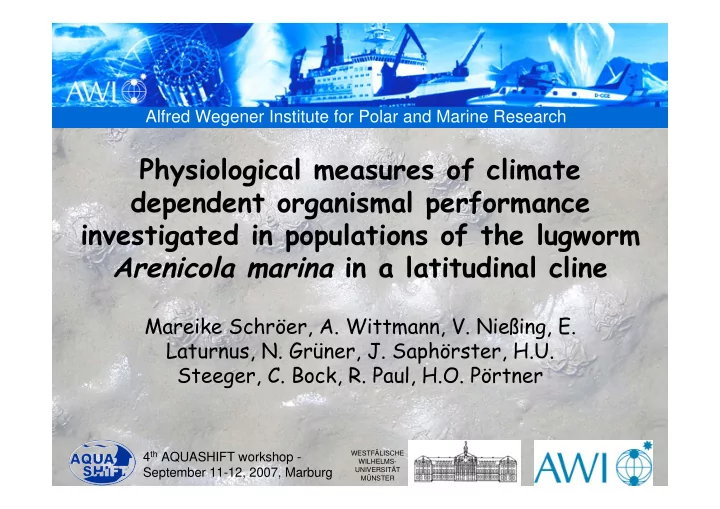

Alfred Wegener Institute for Polar and Marine Research Physiological measures of climate dependent organismal performance investigated in populations of the lugworm Arenicola marina in a latitudinal cline Mareike Schröer, A. Wittmann, V. Nießing, E. Laturnus, N. Grüner, J. Saphörster, H.U. Steeger, C. Bock, R. Paul, H.O. Pörtner 4 th AQUASHIFT workshop - WESTFÄLISCHE WILHELMS- September 11-12, 2007, Marburg UNIVERSITÄT MÜNSTER
Latitudinal Seasonal and adaptation acclimatisation • How does it work? • Is adaptation to climate change possible? 4 th AQUASHIFT workshop - WESTFÄLISCHE WILHELMS- September 11-12, 2007, Marburg UNIVERSITÄT MÜNSTER
Oxygen limited thermal tolerance Tp: pejus temperatures, optimum Oxygen T p T p : loss of performance range thresholds limited oxygen supply limit => aerobic T c T c : anaerobiosis scope decreasing blood oxygenation blood (steady oxygenation Tc: critical temperatures, metabolism state) turns anaerobic anaerobic metabolism survival time limited unless 0 acclimatisation occurs optimum Rate of As seen in fishes, long-term warming aerobic beyond pejus temperatures perfor- (Pörtner and Knust, Science 2007) mance => reduced performance (growth, reproduction, muscle exercise,...) 0 => ecological consequences: Temperature • decreased abundance After: Pörtner et al. 2004 • local extinction Performance curve: oxygen supply • shift in distribution budget above basic metabolism 4 th AQUASHIFT workshop - WESTFÄLISCHE WILHELMS- September 11-12, 2007, Marburg UNIVERSITÄT MÜNSTER
Model organism The lugworm Arenicola marina beside it‘s burrow Longitudinal section of the burrow after F. Krüger 1971 4 th AQUASHIFT workshop - WESTFÄLISCHE WILHELMS- September 11-12, 2007, Marburg UNIVERSITÄT MÜNSTER
Populations White Sea: Kartesh North Sea: Dorum-Neufeld Atlantic: La Hume 4 th AQUASHIFT workshop - WESTFÄLISCHE WILHELMS- September 11-12, 2007, Marburg UNIVERSITÄT MÜNSTER
Haemoglobin Methods properties: Seasonal changes of P 50 (oxygen partial pressure Muscle exercise: when haemoglobin quantification of is half saturated) digging activity 1 artificial burrow 2 oxygen optodes Ventilation and 3 temperature sensors 4 flow probe respiration: recording of pumping activity, volume flow and oxygen consumption 10 cm 4 th AQUASHIFT workshop - WESTFÄLISCHE WILHELMS- September 11-12, 2007, Marburg UNIVERSITÄT MÜNSTER
Results: Latitudinal adaptation Comparison of summer animals in a latitudinal cline: - upper critical temperature - optimum range 4 th AQUASHIFT workshop - WESTFÄLISCHE WILHELMS- September 11-12, 2007, Marburg UNIVERSITÄT MÜNSTER
Results: Latitudinal adaptation Comparison of summer animals in a latitudinal cline: location of exercise performance optimum White Sea: 11°C North Sea: 15°C Atlantic: 23°C 4 th AQUASHIFT workshop - WESTFÄLISCHE WILHELMS- September 11-12, 2007, Marburg UNIVERSITÄT MÜNSTER
Results: Seasonal acclimatisation Comparison of North Sea animals in summer and winter: - upper critical temperature - optimum range 4 th AQUASHIFT workshop - WESTFÄLISCHE WILHELMS- September 11-12, 2007, Marburg UNIVERSITÄT MÜNSTER
Results: Seasonal acclimatisation Comparison of North Sea animals in summer and winter: location of exercise performance optimum Summer: 15°C Winter: 11°C 4 th AQUASHIFT workshop - WESTFÄLISCHE WILHELMS- September 11-12, 2007, Marburg UNIVERSITÄT MÜNSTER
Results: Seasonal acclimatisation Comparison of Atlantic animals in summer and winter: - upper critical temperature - optimum range 4 th AQUASHIFT workshop - WESTFÄLISCHE WILHELMS- September 11-12, 2007, Marburg UNIVERSITÄT MÜNSTER
Results: Seasonal acclimatisation Comparison of Atlantic animals in summer and winter: location of exercise performance optimum Summer: 23°C Winter: 15°C 4 th AQUASHIFT workshop - WESTFÄLISCHE WILHELMS- September 11-12, 2007, Marburg UNIVERSITÄT MÜNSTER
Results: Seasonal acclimatisation Seasonal comparison of North Sea animals: -Temperature in 20 cm depth - Haemoglobin properties: Seasonal changes of P 50 (oxygen partial pressure when haemoglobin is half saturated) - increased P 50 in summer - => facilitated oxygen release to tissues during reproductive phase (June-September) - effects on thermal tolerance and performance 4 th AQUASHIFT workshop - WESTFÄLISCHE WILHELMS- September 11-12, 2007, Marburg UNIVERSITÄT MÜNSTER
Summary T p T p T c T c 0 optimum 0 Temperature Thermal tolerance windows: � seasonal shifts and changing width � latitudinal specialisation 4 th AQUASHIFT workshop - WESTFÄLISCHE WILHELMS- September 11-12, 2007, Marburg UNIVERSITÄT MÜNSTER
Conclusions Climate change: � Our results show capacities to regain balance in oxygen demand and supply with changing temperature. � Global warming: application of the same mechanisms: short-term acclimatisation and long-term adaptation � Summer animals: Have they reached their acclimatisation limits? => adaptation over a larger timescale is necessary � Southernmost populations: Have they reached their adaptation limits? 4 th AQUASHIFT workshop - WESTFÄLISCHE WILHELMS- September 11-12, 2007, Marburg UNIVERSITÄT MÜNSTER
Thank you Questions? for your attention! Comments? Acknowledgements: Biological Stations - Kartesh (Russia) - Arcachon (France) Technicians - R. Wittig - T. Hirse - B. Klein
Recommend
More recommend